
Developing Talent
by
Dennis Van der Meer
President of the U.S.P.T.R. and
Van der Meer TennisUniversity
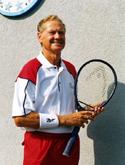 All over the world
there are young players who are blessed with great talent to become top
tennis players, and once these talented players see an example of success,
it is more likely that they will succeed. All over the world
there are young players who are blessed with great talent to become top
tennis players, and once these talented players see an example of success,
it is more likely that they will succeed.
For instance, Marcello Riosí success has spurred many young, talented
players in Chile to try to become the next tennis stars. Tennis agents,
the I.T.F. and the Chilean Tennis Federation also donít want to miss out
on this opportunity.
The top two Chilean number one, fourteen-year-old girl and boy players,
Cristina Condon Bersanetti and Carlos Rios Cortes, came to the Van der
Meer World Class Academy to ensure they had sound fundamental technique
and to build their game.

Carlos Rios Cortes and Cristina Condon Bersanetti, both outstanding
14-year Chilean number one ranked juniors with Dennis Van der Meer
and Teaching Pro Juan Gamboa, who assisted Dennis.
|
Carlosí father is a very good teaching pro who taught his son well,
and my job was to help determine what his future playing style would be
and to develop the strokes necessary.
Carlos and I determined that because his left-handed serve had
potential to become a great weapon he should be developing an attacking
game style.
Development Work - Carlos
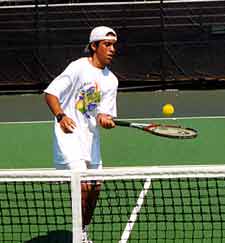
To develop touch on his volley, Carlos bounces the ball off his
racket and then plays a touch volley.
|
Carlos worked hard to develop a wide slice on the ad side of the court
and follow it up with a winning volley. This combination is going to win
him a lot of matches in the future.
He did not have the "soft hands" required to play touch
volleys so I showed him the trick of letting the ball bounce lightly once
on his racket and then gently volley the ball short to any part of the
court. This exercise gave him the feel for a touch volley to complement
his power volley.
His forehand drive was a classic closed stance with his body sideways
to the net. To make his forehand more attacking I showed him how to
"load upí on his left leg by rotating his body and bending his
knees. From this position he now had the choice to step in against the
ball or to accelerate his racket through the ball with a distinct body
rotation toward his right side.
This technique gave him a great deal more racket head speed and enabled
him to make winning shots off any short ball or to attack the net.
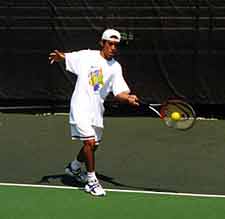 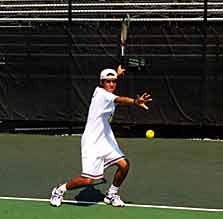
Carlos (above left) had a classic closed-stance forehand drive. He
needed to make his forehand a weapon by loading up on his left
leg.
|
Carlos had some mental problems and would often, under tough
competition find all kinds of excuses for not trying his best. We
discussed the problem, and he agreed that a competitor must always try no
matter what the circumstances.
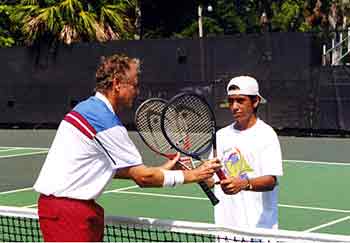
Carlos and Dennis exchange rackets on a critical point to build
fighting spirit.
|
To emphasize this I would, during any critical point in a training
match, stop the game, take away his racket and make him play with an
unfamiliar racket. This helped him very much to not look for excuses and
to compete fiercely all the time.
Cristina
Cristina has a typical clay court game, and like many young players,
her game was mostly defensive, as she scurried 5 meters behind the
baseline. Only her quickness saved her. We determined that she should
become a counter attacker, and as part of some of her development work, we
decided that simply by standing closer in to the base line and using her
opponentís ball speed, she could make winning shots without swinging any
harder.
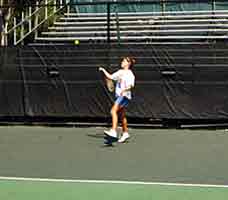 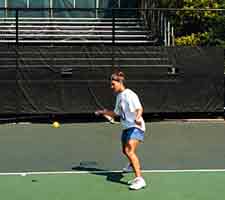
Cristina (above left) was basically a clay court player who
retrieved magnificently several yards behind the base line. To
become a counter puncher, Cristina learned to take the ball early
on the base line.
|
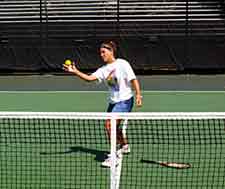 She
also had to improve her volley. She had the mental picture that the racket
head had to be pointing toward the sky at all times. I showed her that the
racket angle to the forearm should be about 125 degrees and should remain
constant, no matter what the height of the ball. By tossing the ball to
her at different heights and having her catch it, she understood it. Once
she understood this, she could volley different heights more effectively,
particularly low shots. She
also had to improve her volley. She had the mental picture that the racket
head had to be pointing toward the sky at all times. I showed her that the
racket angle to the forearm should be about 125 degrees and should remain
constant, no matter what the height of the ball. By tossing the ball to
her at different heights and having her catch it, she understood it. Once
she understood this, she could volley different heights more effectively,
particularly low shots.
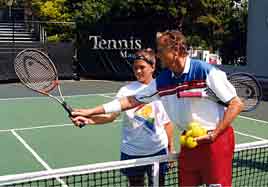 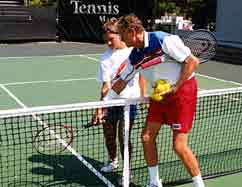
Dennis has to show Cristina how the racket angle stays the same, but
that the racket could be below the wrist or low ball.
|
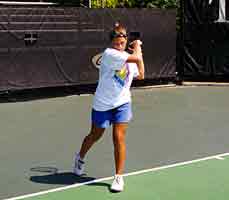
To avoid looking up too early, Cristina exaggerates by not letting
her eyes follow the ball.
|
As a counter puncher, she had many opportunities to hit winners, but
she would quite often miss an easy shot by being distracted by her
opponent or looking at her target spot.
As an exaggerated exercise, I asked her just to have a mental picture
where she wanted the ball to land and not look at the target spot or at
the opponent at all.. By focusing only on the ball, she overcame this
problem and her unforced errors decreased dramatically.
With these guidelines for Carlos and Cristina, hopefully they can build
their games to become future professional-level tennis players.
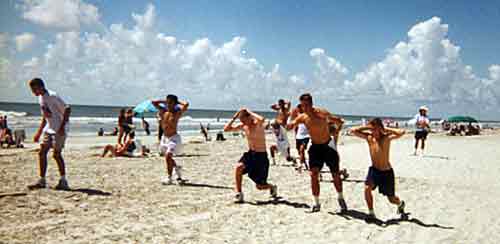
Doing physical training on the beach with all the other
Academy players made it quite painless!
|
Dennis Van der Meer, voted U.S. Olympic Development Coach
of the Year, has taught more people to play and teach tennis
than anyone in the history of the game. From legendary
world champions Billie Jean King and Margaret Court, who received
coaching from Dennis during their careers, he continues to help
develop the games of many ATP players, WTA players and up-and-coming
young players at the Van Der Meer World Class Tennis Academy
located on beautiful Hilton Head Island, South Carolina, USA.
Dennis Van der Meer and his staff can be reached in the USA
by phoning 1-800-845-6138 or faxing (843) 785-7032. From outside
the United States, dial 001-843-785-8388 and fax 001-843-785-7032.
Send E-Mail to tennis@vandermeertennis.com or
stop by the web site: www.vandermeertennis.com
|